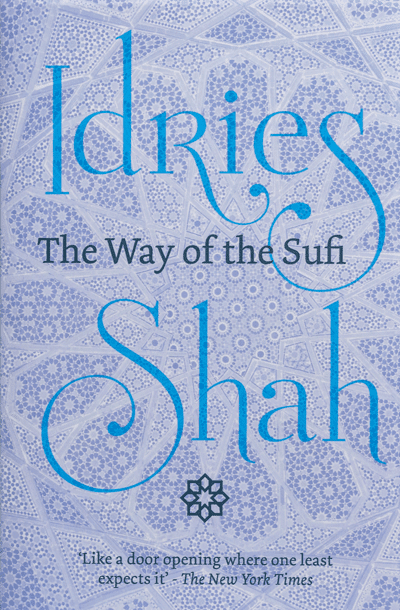AN OUTSTANDING BOOK OF THE YEAR - THE CRITICS, BBC RADIO
The Way of the Sufi is the best-selling follow-up and complimentary work to Idries Shah’s first landmark book on the subject, The Sufis.
Idries Shah’s, The Way of the Sufi is a compendium of traditional tales, poetry, epigrams, anecdotes and sayings from individual Sufis and Sufi schools over the last millennia. Shah’s work presents an unparalleled cross-section of Sufi teachings—from Morocco to Indonesia—as an introductory and basic course of Sufi study.
Included are biographical sketches of some of the best-known Sufi masters from the classical Islamic period, and descriptions of four of the major Sufi orders: the Chisti, Qadiri, Suhrawardi and Naqshbandi schools. Shah considers attitudes to Sufi ideas, and evidence of their existence in other traditions. Medieval Christianity, Hinduism, Buddhism, Jewish mysticism and various modern philosophical teachings, the author shows us, all bear some imprint of Sufi influence.
Shah’s comprehensive and well-sourced introduction conveys the essentially undefinable nature of Sufism, both through what outside observers have in part believed it to be, and also what it is not.
Forming a matrix of disparate yet synergistic materials, The Way of the Sufi illuminates aspects of the Sufi tradition relevant to the contemporary world.
‘[Shah’s] work is as exciting as a good novel.’
THE TIMES LITERARY SUPPLEMENT
‘More wisdom than I have found in any other book this year.’
THE CRITICS
‘It’s seminal stuff, springing mines of suggestive ideas… A key book.’
OBSERVER
‘A great many common Western distortions and misinterpretations are cleared away, and much valuable source material anthologized.’
TRIBUNE
Part One: The Study of Sufism in the West
The Study of Sufism in the West
Notes and Bibliography
Part Two: Classical Authors
1. El-Ghazali
2. Omar Khayyam
3. Attar of Nishapur
4. Ibn el-Arabi
5. Saadi of Shiraz
6. Hakim Jami
7. Hakim Sanai
8. Jalaludin Rumi
Part Three: Four Major Orders
Four Major Orders
1. The Chishti Order
2. The Qadiri Order
3. The Suhrawardi Order
4. The Naqshbandi Order
Part Four: Among the Masters
A Meeting with Khidr
Part Five: Teaching-Stories
Part Six: Themes for Solitary Contemplation
Solitary Contemplation Themes
A Sufi Notebook: Some Contemplation-Themes
Part Seven: Group Recitals
Part Eight: Letters and Lectures
Part Nine: Questions and Answers on Sufism
1. Sufism and Islam
2. Deep Understanding
The Sufi is one who does what others do –
when it is necessary. He is also one who does
what others cannot do – when it is indicated.Nuri Mojudi
SO many people profess themselves bewildered by Sufi lore that one is forced to the conclusion that they want to be bewildered. Others, for more obvious reasons, simplify things to such an extent that their ‘Sufism’ is just a cult of love, or of meditations, or of something equally selective.
But a person with a portion of uncommitted interest who looks at the variety of Sufi action can see the common characteristic staring him in the face.
The Sufi sages, schools, writers, teachings, humour, mysticism, formulations are all connected with the social and psychological relevance of certain human ideas.
Being a man of ‘timelessness’ and ‘placelessness’, the Sufi brings his experience into operation within the culture, the country, the climate in which he is living.
The study of Sufic activity in distant cultures alone is of value only to those working in the narrow field of scholasticism. Considering Sufi activities as merely religious, literary or philosophical phenomena will produce only garbled renditions of the Sufi way. To try to extract theory or system and to attempt the study of it in isolation is just as comparatively profitless.
This book is designed to present Sufi ideas, actions and report: not for the microscope or as museum-pieces, but in their relevance to a current community – what we call the contemporary world.
IDRIES SHAH
From The Way of The Sufi by Idries Shah
Copyright © The Estate of Idries Shah
Idries Shah was born in India in 1924 into an aristocratic Afghan family. He was an author and teacher in the Sufi tradition and is considered one of the leading thinkers of the 20th century.
Shah devoted his life to collecting, translating and adapting key works of Sufi classical literature for the needs of the West. Called by some 'practical philosophy' - these works represent centuries of Sufi and Islamic thought aimed at developing human potential. His best-known works include the seminal book The Sufis, several collections of teaching stories featuring the ‘wise fool’ Nasrudin, Reflections and Knowing How to Know.
Shah's corpus - over three dozen books on topics ranging from psychology and spirituality to travelogues and cultural studies - have been translated into two dozen languages and have sold millions of copies around the world. They are regarded as an important bridge between the cultures of East and West.
Paperback
Amazon paperback
Bookshop.org paperback
ISBN: 978-1-78479-024-0
Language: English
Number of pages: 356
Hardcover
Amazon hardcover
Bookshop.org hardcover
ISBN: 978-1784799083
Language: English
Number of pages: 356
Ebook - Kobo
Kobo eBook
ISBN: 978-1-78479-026-4
Number of pages: 261
Duration: 5-6 hours to read
Total words: 75k
Ebook - Kindle
Kindle Edition
ASIN: B08KFM7WBL
Print length: 356
File size: 2755 KB
Audiobook
Audible Audiobook
ASIN: B00WGVPN0I
Listening length: 8 hours 51 minutes
Narrator: David Ault
All editions of The Way of the Sufi published by ISF are available in American-English Editions.
